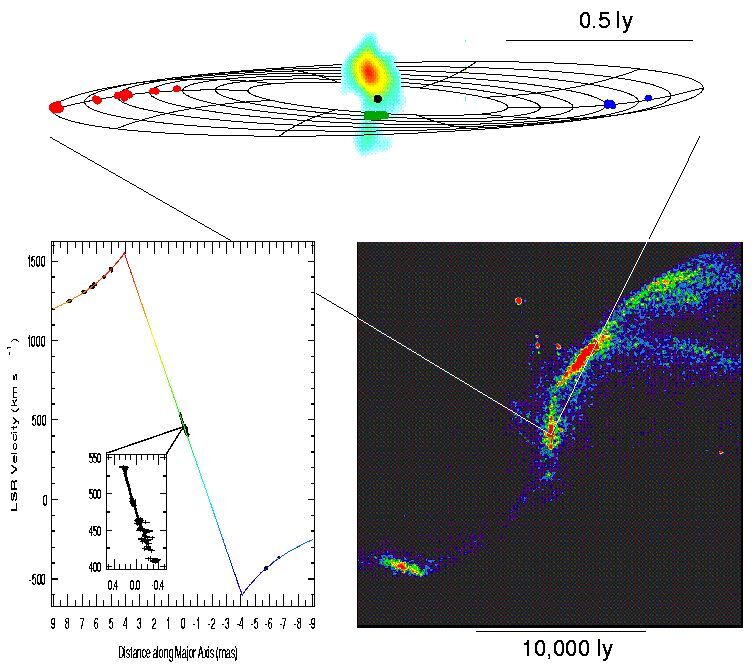NGC 4258
Description
NGC 4258 is a Seyfert galaxy in the constellation Ursa major. It is generally agreed to have at its heart a supermassive black hole some 39 million times more massive than the Sun. Gas orbiting this black hole has formed a warped disk nearly two light years in diameter. By measuring extremely small shifts in the positions of H2O masers (water vapor that amplifies microwave radio emissions) located in this disk, scientists have been able to measure the distance to this galaxy as 23.5 million light years, a measurement the scientists say is accurate to within a million light years. The disk is viewed nearly edge-on from Earth and orbits the black hole at a speed of more than 2 million miles per hour. Using the Very Long Baseline Array, the astronomers observed the Doppler shift of the masers at the disk's sides at 4 to 8 month intervals over more than three years. This shift, or "proper motion," combined with previous observations in which astronomers had measured the speed of the orbiting disk and ascertained the mass of the black hole, has enabled the scientists to make the distance determination. Previous observations using Cepheid variable stars and the Hubble Space Telescope had set the distance at 27 or 29 million light years. The difference in these two distance determinations will make a significant impact on future calculations of the size and age of the Universe.
The color image in the lower right of the above compiliation is a combination of VLA A+B+C-array observations at 20cm (1.4 GHz), from Cecil et al. 2000 (see link to Journal article below). The graphic at the top of the compilation shows the VLBA continuum image in falsecolor, with red and blue dots representing the location of H<sub>2</sub>0 masers, and a wire-frame representation of the acretion disk around the radio source. The black dot at the center of the image indicates the supposed location of the central black hole. The panel in the lower left of the compilation shows the velocities of the masing regions and the best fit rotation curve to the data. This rotation curve allows astronomers to infer the mass of the inner black hole.
Creator
Legacy Astronomical Images
Rights
NRAO/AUI/NSF does not hold full copyright for this image. Contact the archivist for details.
Type
Legacy Astronomical Image
Object Name
NGC4258
Photographer
Investigators
J. M. Moran, L. J. Greenhill, J. R. Herrnstein
Telescope
Very Large Array (VLA)
Very Long Baseline Array (VLBA)
Effelsberg
Observation Date
1999-00-00
Type of Observation
continuum
Center of Image
RA 12:18:57.520, Dec: 47:18:14.200 (J2000)
Link to journal article
Series
Active Galactic Nuclei Series
Unit
Seyferts Unit
Citation
Legacy Astronomical Images, “NGC 4258,” NRAO/AUI Archives, accessed June 14, 2025, https://www.nrao.edu/archives/items/show/33407.

